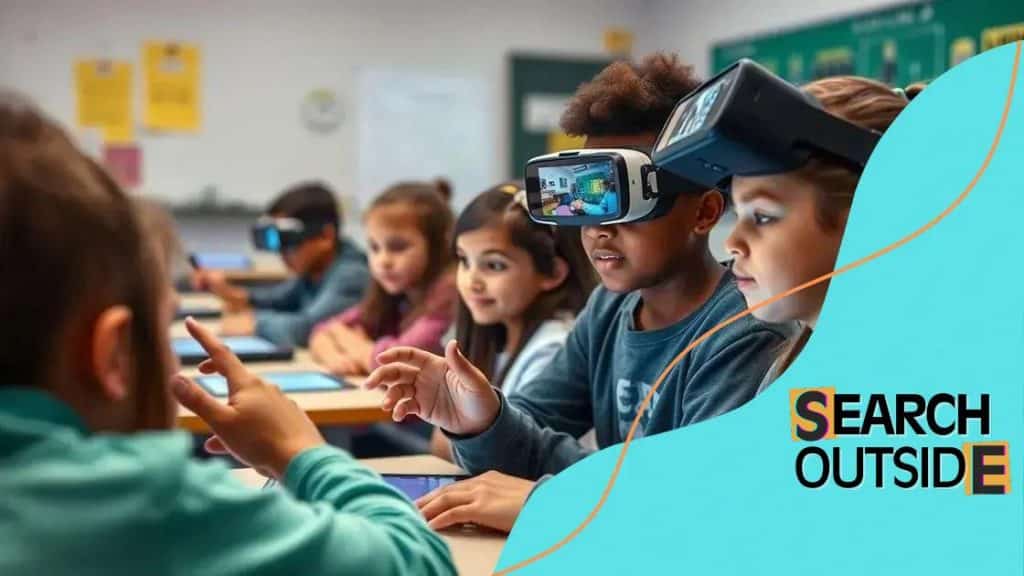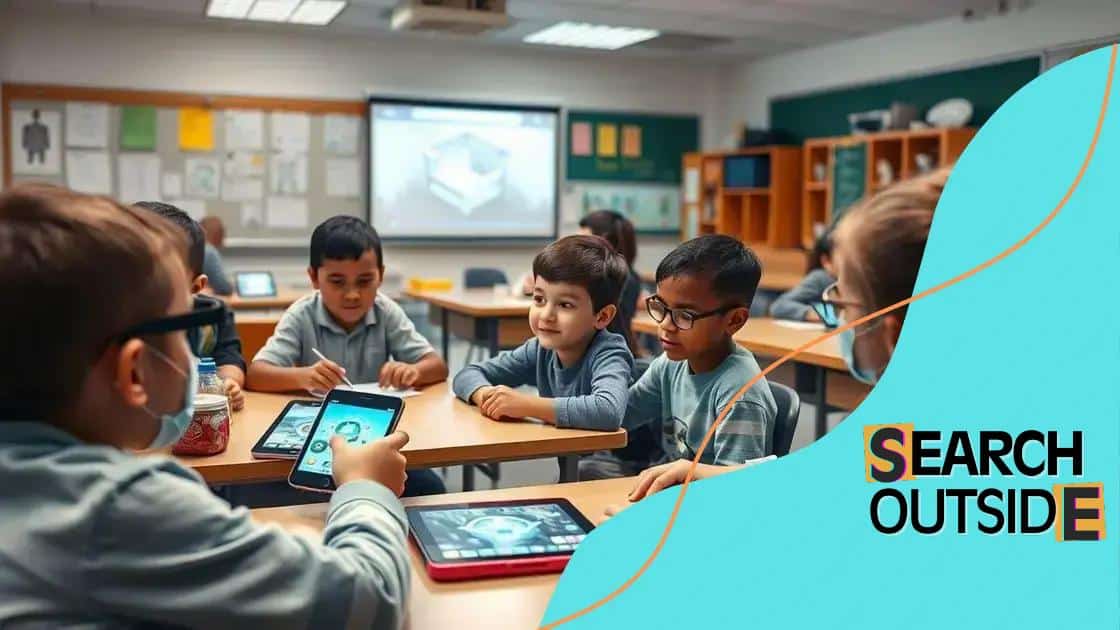How augmented reality is changing STEM education

Augmented reality is transforming STEM education by providing interactive and engaging learning experiences that enhance understanding and retention while addressing diverse student needs.
How augmented reality is changing STEM education is a topic that’s gaining traction. Imagine students exploring complex concepts through interactive simulations! This technology opens doors to innovative learning methods that can reshape the classroom experience.
Understanding augmented reality in education
Understanding augmented reality (AR) in education is more important than ever. With its potential to transform learning, AR creates immersive experiences that engage students. By incorporating interactive components into lessons, educators can enhance how students grasp complex ideas.
What is Augmented Reality?
Augmented reality is a technology that overlays digital information onto the real world. This means students can see 3D models, simulations, and animations superimposed on their physical surroundings. For example, a science lesson about the solar system can come to life as students view planets floating in their classroom.
Benefits of Using Augmented Reality
- Enhanced engagement: AR captivates students, drawing them into the material.
- Improved retention: Visual and interactive elements help reinforce learning.
- Accessibility: AR can cater to various learning styles, making education more inclusive.
- Real-world applications: Students can connect classroom lessons with real-life scenarios.
When educators use AR, the benefits extend beyond engagement. This technology helps students interact with abstract concepts in a more tangible way. Instead of merely reading about the human body, they can explore a 3D model, enhancing their understanding.
Another exciting aspect of AR in education is its versatility. It can be used across subjects, from art to math. For instance, in an art class, students can use AR to visualize how different colors blend on a canvas, bringing their creativity to life.
Challenges in Implementing AR
Despite its many advantages, there are challenges to consider. Some educators may lack the necessary training to effectively utilize AR tools. Furthermore, not all schools have access to the latest technology. Addressing these challenges is essential to ensure that all students can benefit from augmented reality in the classroom.
As AR technology continues to develop, so too does its potential in educational settings. With ongoing advancements, the future of learning looks bright. Educators are expected to leverage AR more fully, providing students with richer, more interactive experiences that prepare them for a technology-driven world.
Benefits of augmented reality in STEM
The benefits of augmented reality (AR) in STEM (Science, Technology, Engineering, and Mathematics) education are numerous and impactful. By integrating AR technology into lessons, educators can create interactive and immersive experiences that enhance student learning.
Enhanced Engagement
One of the most significant benefits of AR is its ability to enhance student engagement. When students interact with digital elements that overlay their real-world environment, they become more interested in the subject matter. For instance, a math lesson can turn into an exciting game where students solve problems to unlock virtual rewards.
Improved Understanding
- Visual learning: AR helps students visualize complex concepts through 3D representations.
- Real-time feedback: Immediate responses to student actions encourage exploration.
- Hands-on experience: Students can manipulate objects in a virtual space to understand dynamics better.
Understanding abstract ideas becomes easier through these engaging visuals. For example, physics lessons on forces can come alive as students see how different variables affect motion in a simulated environment. This practical approach can help clarify difficult topics that are often challenging to grasp through traditional methods.
Another major benefit of AR is that it caters to different learning styles. Some students learn best through visuals, while others prefer hands-on activities. AR allows for a combination of these methods, enabling a more inclusive learning experience. This adaptability can lead to better retention of information and improved academic performance.
Collaboration and Teamwork
Augmented reality also promotes collaboration among students. Working on AR projects encourages teamwork as students share devices and ideas. Imagine a science experiment where students collaborate to build a virtual ecosystem. This promotes social skills while reinforcing content knowledge.
The integration of AR in STEM education not only motivates students but also prepares them for the future job market. As technology continues to evolve, familiarizing students with AR tools equips them with valuable skills applicable in various careers. Learning through augmented reality shapes innovative thinkers ready to tackle real-world challenges.
Practical applications of AR in classrooms

Practical applications of augmented reality (AR) in classrooms are transforming the way educators teach and students learn. This innovative technology provides numerous opportunities for interactive learning experiences that engage students in meaningful ways.
Interactive Math Lessons
In math classes, AR can create immersive environments where students visualize complex problems. For example, students can solve geometry problems by manipulating 3D shapes in augmented reality. This hands-on approach helps them understand angles and dimensions much better than traditional methods.
Science Experiments
- Students can conduct virtual dissections without harming animals.
- AR allows for exploring the human body in detail through 3D models.
- Weather phenomena can be visualized, showing real-time effects of climate change.
When it comes to science, AR can simulate experiments that might be too dangerous or expensive to conduct in a typical classroom. Imagine students witnessing a volcanic eruption or a chemical reaction without any risk! This type of learning not only makes education fun but also enhances understanding of scientific concepts.
Additionally, in history classes, students can travel back in time. Using AR, learners can explore historical sites, interact with famous figures, and witness key events. For instance, they could view a 3D reconstruction of ancient Rome right in their classroom. Such experiences make history come alive and encourage a deeper connection to the material being studied.
Language Learning
AR also plays a crucial role in language learning. By using AR apps, students can point their devices at objects to see their names in different languages. For example, a student pointing at an apple might see “apple” in English and its translation in Spanish. This immediate visual aid supports vocabulary retention and pronunciation.
Furthermore, AR can foster collaboration among students. Group projects involving AR encourage teamwork as students work together to create content or solve problems. It helps them develop essential skills like communication and collaboration while engaging in the learning process.
Challenges of implementing augmented reality
Implementing augmented reality (AR) in educational settings comes with several challenges. While the benefits are evident, the obstacles can hinder effective integration of this innovative technology.
Technical Issues
One common challenge is the technical complexity of AR systems. Schools may face difficulties in selecting the right software and hardware. Not all devices support AR, which can lead to inconsistent experiences for students. Additionally, schools may lack the necessary internet bandwidth to support AR applications effectively.
Teacher Training
- Inadequate training: Many educators are not familiar with AR tools.
- Resistance to change: Some teachers may prefer traditional teaching methods.
- Lack of resources: There may be limited access to training materials.
Another significant barrier is the need for proper training. Teachers often require guidance on how to incorporate AR into their lessons. Without adequate training, they might feel overwhelmed or unsure about using technology effectively. This hesitation can prevent them from fully embracing AR tools in the classroom.
Furthermore, the cost of AR technology can be prohibitive for many schools. Budget constraints may limit the ability to acquire devices or software necessary for implementing AR. Schools with fewer financial resources might struggle to provide equitable access to AR experiences.
Curriculum Integration
Integrating AR into existing curricula can also be challenging. Educators need to align new technology with learning objectives effectively. For some subjects, it may be difficult to find suitable AR resources that complement the content being taught.
Lastly, ensuring that all students can access AR technology is crucial. Schools must consider the diverse needs of their students, including those with disabilities. Designing inclusive AR experiences can be an additional challenge for educators and software developers.
Future trends of augmented reality in education
The future trends of augmented reality (AR) in education look promising and innovative. As technology advances, the integration of AR in classrooms is expected to become more seamless and impactful.
Personalized Learning Experiences
One significant trend is the move toward personalized learning experiences. AR offers tailored educational content that can meet individual student needs. For instance, students struggling with specific subjects can access targeted AR resources that focus on their weak areas. This ensures that each learner progresses at their own pace, allowing for deeper understanding and retention.
Increased Accessibility
- Widespread availability: Advances in mobile technology make AR tools accessible to more students.
- Enhanced inclusivity: Developers are creating AR experiences that cater to diverse learning needs.
- Remote learning: AR can bridge gaps in education for students in remote areas.
As AR applications become more widespread, there will be a significant increase in accessibility. With the rise of smartphone and tablet usage, students can utilize AR experiences anywhere, anytime. This accessibility can help bridge educational gaps, enabling students in underserved areas to access high-quality learning resources.
Moreover, AR is likely to evolve in terms of interactivity. Future apps may incorporate features like voice commands and gesture recognition, enabling students to engage with content more naturally. Imagine students asking questions to a virtual tutor while exploring complex concepts.
Collaboration Across Platforms
Collaboration is another area where AR will flourish. As educational institutions adopt AR technology, there will be opportunities for students to collaborate on projects remotely. With shared virtual spaces, students can work together, no matter their physical location. This promotes teamwork and helps prepare students for the global workforce.
Furthermore, AR is expected to be integrated with other emerging technologies, like virtual reality (VR) and artificial intelligence (AI). These intersections can create even richer learning experiences, offering students a comprehensive understanding of various subjects. For example, students can explore an interactive 3D model of a planet while using AI to answer questions about its characteristics.
FAQ – Frequently Asked Questions about Augmented Reality in Education
What is augmented reality in education?
Augmented reality (AR) in education uses technology to overlay digital information on the real world, creating interactive and engaging learning experiences.
How does AR enhance student engagement?
AR makes learning more interactive by allowing students to visualize complex concepts and participate in immersive experiences, which keeps them interested and motivated.
What are some challenges of implementing AR in classrooms?
Challenges include technical issues, the need for teacher training, budget constraints, and integrating AR into existing curricula.
What future trends can we expect for AR in education?
Future trends may include personalized learning experiences, increased accessibility, greater interactivity, and improved collaboration among students.





